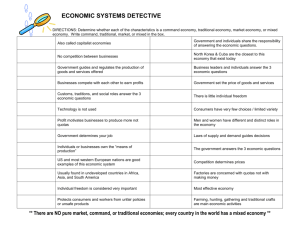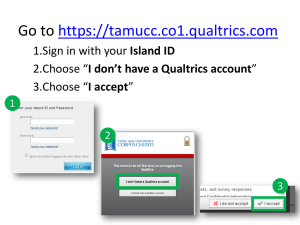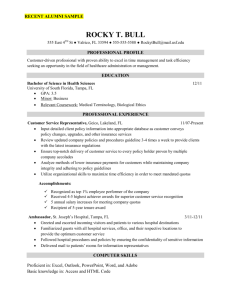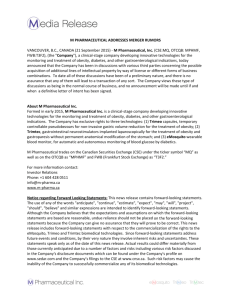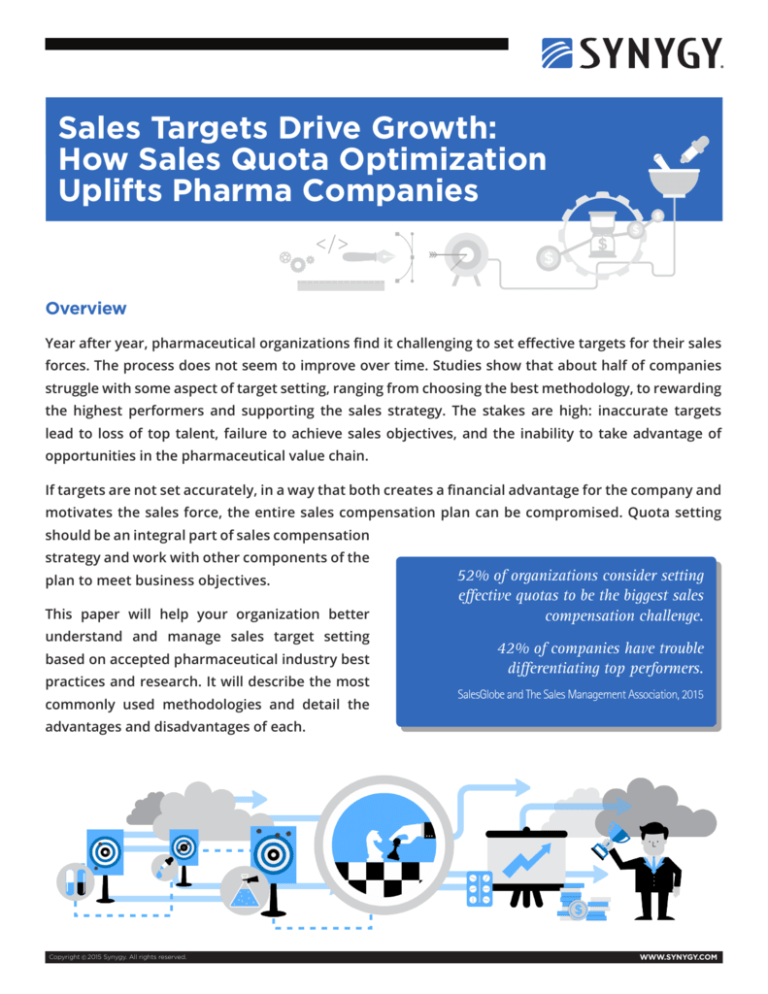
Sales Targets Drive Growth:
How Sales Quota Optimization
Uplifts Pharma Companies
Overview
Year after year, pharmaceutical organizations find it challenging to set effective targets for their sales
forces. The process does not seem to improve over time. Studies show that about half of companies
struggle with some aspect of target setting, ranging from choosing the best methodology, to rewarding
the highest performers and supporting the sales strategy. The stakes are high: inaccurate targets
lead to loss of top talent, failure to achieve sales objectives, and the inability to take advantage of
opportunities in the pharmaceutical value chain.
If targets are not set accurately, in a way that both creates a financial advantage for the company and
motivates the sales force, the entire sales compensation plan can be compromised. Quota setting
should be an integral part of sales compensation
strategy and work with other components of the
plan to meet business objectives.
This paper will help your organization better
understand and manage sales target setting
based on accepted pharmaceutical industry best
practices and research. It will describe the most
commonly used methodologies and detail the
52% of organizations consider setting
effective quotas to be the biggest sales
compensation challenge.
42% of companies have trouble
differentiating top performers.
SalesGlobe and The Sales Management Association, 2015
advantages and disadvantages of each.
Copyright © 2015 Synygy. All rights reserved.
WWW.SYNYGY.COM
The Benefits of Sales Target
Optimization
Commonly Used Target Setting
Methodologies
Executing any business strategy depends on the
cooperation and proper functioning of all levels of
the sales organization. Target setting is an integral
part of strategy execution and, when done correctly,
enables sales organizations to:
Flat Quotas Approach
Sales representatives and sales managers aim at a specific
goal that is both attainable and challenging, and one that
they understand and consider fair.
Allocating flat quotas means giving the same commission
rate to all sales representatives. While this might work
for small sales forces or markets with unconstrained
potential, it is not realistic for organizations with complex
operations and objectives. The advantages of a simple
quota system are quickly overshadowed by the lack of
performance-based rewards and inequitable targets,
and also by the inefficiency resulting from a strategy
that doesn’t account for business insights.
Offer equal earning opportunity for all
Historic Quotas Approach
Motivate salespeople
Accurate goal setting rewards commitment, talent, passion
and results, regardless of local market circumstances.
Achieve compensation objectives
Fair targets link pay directly to performance and
clearly differentiate low and high performers, helping
retain top talent.
Remain flexible to market changes
Optimal target setting allows sales managers to quickly
adapt to changes and respond to the complexities of the
pharmaceutical value chain.
Achieve sales goals
With a motivated sales staff and targets that are
specifically designed to support the sales strategy, the
organization can reach its sales objectives.
Historic quotas are set by looking at what happened in
the past and, on that basis, adding a projected increase.
They are a popular methodology with companies because
of the rather straight-forward calculation, as compared to
more complex models that consider an array of variables.
Historic quotas are also easy to understand by the sales
force and don’t require a lot of data or business insights.
There are considerable disadvantages of this methodology
though, the most important being that it only looks in the
rearview mirror, disregarding future opportunities and
changing business objectives. Another drawback is that it
tends to punish high performers: their reward for hitting
the target is receiving a higher one the following year.
Maintenance and Growth Approach
A step forward from the first two approaches, the
maintenance and growth methodology is based on
qualitative insights, and it uses factors and weights to
allocate growth over the baseline volume. This approach
is effective in that, unlike the previous methodologies, is
driven more by market opportunity. The challenge is to
achieve consensus on which factors and weights to use in
the model. This methodology might also underestimate
momentum from past sales.
48% of companies use historic quotas.
SalesGlobe, 2015
Copyright © 2015 Synygy. All rights reserved.
WWW.SYNYGY.COM
Regression-Based Approach Recommended for Pharma Companies
In the pharmaceutical industry, deciding how to set sales targets can make the difference between a company
thriving or merely surviving. Synygy recommends a regression-based approach to target setting for pharma
companies because it allows for high accuracy while providing both motivational and financial advantages. On
the down side, this approach is complex, requires additional data, and might prove difficult to communicate.
However, these obstacles can be overcome with the right systems, processes and expertise.
There are 5 steps in regression-based target setting:
1. Identify factors that impact sales
These can be sales factors, such as historical
product, market and share volume, and
historical growth rates; or non-sales factors, such as
method of payment, demographics, inventory levels and
customer satisfaction. We recommend avoiding these
factors: salesperson tenure, previous period quota
attainment and skills rating.
2. Build regression model and
evaluate factors
At this stage, data drives results. Run the
regression model and eliminate extraneous and crosscorrelated variables. Select the 2-4 most important
factors in the model based on key metrics.
3. Finalize and evaluate model
A qualitative analysis follows the quantitative
one. Adjust the model based on business
insights, market landscape and anticipated changes.
Lastly, test the model to verify that it allocates goals
correctly. Here is where outliers are identified and bias
is removed, so that all reps enjoy fair sales targets.
Copyright © 2015 Synygy. All rights reserved.
4. Allocate goals
Using the data at hand, use the model
to predict future performance and to
translate it into contributions.
5. Communicate targets
This step is crucial to having a motivated sales
force. Make sure to communicate targets
prior to the beginning of the goal period. Every sales
rep should understand his or her target and how it was
calculated, and they should also have visibility into the
trends that show why objectives are achievable.
Typical Outcomes Achieved with
Regression-Based Target Setting:
•
•
•
•
Increased accuracy
Reduced bias
Fewer adjustments
Improved communication
WWW.SYNYGY.COM
Conclusion
Target setting is a challenge that remains high on the list of sales compensation problems. For the
pharmaceutical industry, the process is all the more crucial for meeting growth objectives. While the
regression-based target setting methodology is more technical and requires more expertise than other
approaches, in Synygy’s over 20 years of experience in the industry, it is the only one that truly performs in
terms of financial control, increased levels of motivation of sales reps, and improved sales.
Optimizing your company’s target setting process may be challenging because it requires the cooperation
of different departments and roles and may imply adjustments on different levels. However, change is
imperative for organizations to stay competitive and flexible, and to successfully tackle the complexities of
the pharma value chain.
Copyright © 2015 Synygy. All rights reserved.
WWW.SYNYGY.COM
LEVERAGING CHANGE TO IMPROVE OUTCOMES
As the pace of change accelerates many organizations are finding it increasingly challenging to
drive sales performance effectively through in-house people, processes, or technology. If you are
struggling to keep up with changes in strategy, markets, or priorities and drive sales performance,
we invite you to contact us for further discussion on methods for implementing these tips in your
organization and examples of how Synygy’s agile sales performance has improved the outcomes
of hundreds of the world’s largest organizations.
ABOUT SYNYGY
TM
Synygy provides Sales Performance Management as a Service . This enables sales organizations to
rapidly adapt to changes in strategy, markets, and priorities. We do this by combining business process
outsourcing and cloud technology, which makes change a simple and routine part of sales incentive
compensation management, sales operations management, and sales performance management.
PRODUCING BETTER BUSINESS OUTCOMES
Based on client evaluations spanning more than two decades Sales Performance
Management as a Service (SPMaaS) clients report better business outcomes
compared to SPM Software clients in all ten measured categories.
greatest impact:
ABILITY TO ADAPT
TO CHANGE
15
% Better
Process
Reliability
13
%
Cost Savings
Visit our website for more research, expert tips and
trends on sales performance.
Or contact us directly to speak with one of our Consultants.
info@synygy.com
+1 610.494.3300 x7900
Follow us on Social Media
Copyright © 2015 Synygy. All rights reserved.
Share!
WWW.SYNYGY.COM

